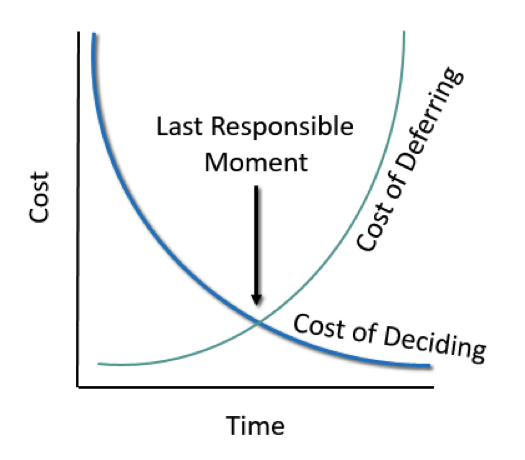Want to make better decisions? Then wait until the last responsible moment.
Whether the decision is for Agile product development, program management, or any area of business or life, waiting until the last responsible moment is a lean concept that will ensure that you make the best decisions possible. Sound crazy? Hear me out…
Waiting until the last responsible moment may sound irresponsible. It certainly goes against everything you may have been taught by your parents and teachers, or what you have come to expect at the workplace. However, this lean concept, embraced within Agile thinking, actually produces the most optimal outputs possible by waiting until the last responsible moment. How is that, you say? I’m glad you asked.
Decision Dilemmas
Have you ever made a decision that you later wished you had waited to make because some new information came along that would have influenced you in another direction? Or, perhaps you recall a time when you delayed a decision just a little too long and then missed out on some opportunity?
I suppose it is possible to fall into either one of these categories and not realize it, but chances are, you can think of a few times when the timing was off on a decision or two. Thus, you know firsthand that decisions present dilemmas.
That said, not having all the answers is not a good excuse for not proceeding. You will rarely have all the answers up front. You won’t likely figure it all out in planning. There will often be unknowns and some risks. Anything worth doing is worth doing poorly, but you can minimize the negative impacts.
3 Types of Decisions
There are early decisions, late decisions, and decisions made at the right time. The only ones you likely will never regret are the ones made at the right time, and those decisions are what lean proponents call “the last responsible moment.”
As the graphic below demonstrates, there is a cost of deciding and a cost to deferring. The last responsible moment is that perfect intersection.

Early Decisions
Dilemma: You may likely be wrong
The fact is, you know the least about a situation earlier in the process than you will later on. This is why large up-front plans make no sense. The less you truly know and understand about a thing, the less confidence you should have in the decision. Therefore, making a decision too early is risky and the chances are you may be wrong.
Dilemma: You may produce the wrong thing
If you make a decision too early you may produce the wrong thing. This is very common in product development where guesses are made up front rather than waiting for an empirical process (do, experience, learn, and adjust) to play out and better inform decisions.
Dilemma: Your early decision may cause rework
As a result of making a decision too early and then producing the wrong thing, the outcome is rework, which is then required to correct the mistake based on a later decision (aka late decision). You cannot avoid ever building the wrong thing, because all you really work with are assumptions that need to be validated, but you can reduce the likelihood of being wrong by deciding at the last responsible moment.
Late Decisions
Dilemma: You may miss out on opportunities
If you wait too long to make a decision, the opportunity that was available may very well be gone. Do not mistake this with waiting so long the problem goes away, which would be a good thing, but rather this is about missing out on opportunities. For example, you may only have a small window of opportunity to be first to market with a product or feature. Wait too long and you will miss it.
Dilemma: Your late decision may cause rework
When you wait too long to make a decision, it is quite possible the team already produced something that then needs to be reworked once your decision is made. This is closely tied to the dilemma of making a decision too early.
Perfect Decisions: The Last Responsible Moment
There may not actually be such a thing as a perfect decision, but there certainly is an optimal time to make it. As you can see from the earlier graphic, there is a cost of deciding and a cost of deferring and the last responsible moment sits perfectly at the intersection. It will be hard to always perfectly time your decisions, and only you will know where that point is, but the key is to understand that there is an optimal decision making point.
It is also important to understand that the key word here is “responsible” – the last “responsible” moment.
How To Make Responsible Decisions
So, the last responsible moment is the best time to make a decision. That’s great, but how do you know when that is? How do you make “responsible” decisions?
Assess the cost of deferring
First, you have to determine as best you can the cost of deferring the decision. What happens if you do not make this decision right now? Not every decision needs to be made – at least not right now. As long as the cost of deferring is low, you can afford to wait. But wait on what?
What you are waiting for is more information from which to inform the decision. This could come from:
User feedback
You may feel like you know what the users want and need and what they would like or dislike, but do you really know for sure? Can you back up those assumptions with any data? Often times, it is better to leave something out if you are unsure and allow user feedback to tell you if it is needed. Many times, what you end up with in this instance is different than what you would have guessed.
For example, did you know that the original iPhone did not have copy/paste functionality? It was unknown whether it would be needed on this new platform at the time. It was not until the iPhone 3 that copy/paste capability was available. Granted, there were some technical challenges to solve, but user feedback ultimately made solving those challenges important.
Organizational policies
Let’s face it, organizational policies and mandates can sideswipe your best intentions. These are constraints you need to work within, so you may want to wait and see how certain organizational changes play out before making certain decisions.
External factors
Government regulations, markets, weather, social movements, and more are external factors that can influence how your decisions work out, or not. If something is currently brewing that may impact your business or product, wait as long as you can to see how it plays out.
Technical discovery
Anytime your team produces something new, which often happens in product development, it always goes into development with some unknowns. These unknowns become discoveries throughout the project. Is such and such a feature feasible? Can it be done, or can it be done efficiently? Is this the right way to solve this particular problem? Think back to the original iPhone example here. Prototyping helps you answer some of those questions, sometimes you learn real-time, which then informs where you should go next.
Assess the cost of deciding
If the cost of deferring is not so clear or seems to rise, then you may be closer to needing to make the decision. The next thing you will need to consider is what is the cost of deciding right now? Do you foresee any new information that could come along and change this decision in the near term – before you can see value from it?
You can attempt to anticipate, but confidence is built upon the information you have in the moment. How confident you are in that decision is unique and personal to you.
You cannot avoid sometimes doing the wrong thing, because all you really work with are assumptions that need to be validated, but you can reduce your risk by waiting a little longer — to better know what you’re doing.
Decisions you make now should be things the team is ready to act upon very near term. Otherwise, you will waste time and effort making decisions on what may never actually happen.
Key Takeaways
Lean is all about eliminating waste and doing things Just-in-Time (JIT). Making a decision at the last responsible moment could not be more just in time. Remember, though, the key word here is “responsible.”
Here are a few key takeaways:
- You know the least early on, so early decisions should feel less confident
- Early decisions are more risky due to the impacts of pending change
- Time and effort making decisions on things you will not do for a while is wasted effort – you may never actually need what was decided (think requirements analysis for low priority items)
- Focus on what you know today and assess the risk of the unknown
- Do not spend much time on something that likely will change by the time you touch it
- Not every decision needs to be made, at least not now

